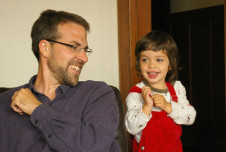Some dads are very involved in the lives of their children—while other fathers neglect, ignore, or even abuse their kids. That’s a fact.
Are there biological factors that could help explain why some fathers are more nurturing than others? That’s the question being explored by Emory University anthropologist James Rilling in a series of innovative studies that are documenting how differences in hormone levels, sexual anatomy, and brain activity seem to relate to involvement with children.

We know quite a lot about the biological changes that occur in women when they become mothers. At the most visible level, their hips spread and their breasts swell. There are also changes that aren’t visible to the naked eye: New neurons and connections develop in the grey matter of their brains, for example, and their bodies are flooded with hormones like oxytocin that facilitate bonding with an infant.
For many, many years, we assumed that men’s bodies did not change when they became fathers, which probably seemed logical, since males cannot bear or nurse children. As a result, researchers knew almost nothing about which biological factors might drive fathers to spend time caring for their children—and which ones might interfere.
Then, starting in the early 2000’s, Anne E. Storey, Katherine Wynne-Edwards, and other scientists began to document hormonal shifts in the male body as well, such as losing testosterone and gaining prolactin, a hormone involved in human milk production. Their studies also suggested that these hormonal shifts only happened when the fathers were in steady contact with the mothers and infants, hinting at the ways environmental factors could shape men’s bodies as children come into their lives.
Since 2013, Rilling and his colleagues have taken this line of research to a new level with surveys, genetic analyses, and brain imaging. They’re discovering what the body and brain of an involved dad looks like—and how it might be different from that of a less-involved father. Their key findings are controversial, to say the least—the interplay between biology and behavior always is—but their work is yielding new insights about what happens in a man’s body as he becomes a father.
How Dad’s brain responds to crying babies
What biological force seems to exert the most influence over men’s caregiving behavior? In one word: testosterone.
But while that hormone keeps turning up in studies of men’s caregiving behavior, it’s not the only influence. In a 2014 study (funded by the John Templeton Foundation, which also supports the Greater Good Science Center), Rilling and colleagues recruited 88 fathers of young children and 50 unmarried men who were not fathers. They found that the fathers had significantly higher levels of the hormone oxytocin in their blood when compared with the non-fathers.
This was no surprise: a great deal of prior research linked oxytocin to nurturing behavior, in both dads and moms. One study, for example, found that fathers dosed with oxytocin before playing with their toddlers showed less hostility and more support for their kids’ learning and exploration, compared with fathers who were given a placebo.
In addition, Rilling and colleagues used functional magnetic resonance imaging, or fMRI, to study brain activity when the fathers and non-fathers looked at either pictures of children or images intended to provoke a sexual response.
The researchers found that when fathers looked at the child pictures, they showed greater activation than non-fathers in brain areas known to be involved in the processing of facial expressions (the caudal middle frontal gyrus) and thinking about the mental states of other people (the temporo-parietal junction). In response to the sexual images, the non-fathers showed greater activation in brain regions associated with reward and motivation (the dorsal caudate and nucleus accumbens) than the fathers did. Taken together, these results suggest that fathers are putting more energy into thinking about other people and their needs—and much less energy into chasing what they want.
This leads us back to the critical role of testosterone. In this study, fathers also had significantly lower levels of testosterone than non-fathers. Putting time and effort into childcare may lower testosterone levels in fathers, suggest Rilling and his co-authors, which in turn may help shape their brain responses so that they are more empathetic toward children, a result consistent with many other studies.
Testosterone shows up as a factor in another study published in Social Cognitive and Affective Neuroscience, in which Rilling and his collaborators investigated what brain activity infant cries provoked in the brains of fathers.
The fMRI scans found that crying elicited increased activity in the anterior insula and the inferior frontal gyrus—regions thought to be involved in empathy. They also found that men who were less sensitive to testosterone (because they had a particular version of a gene called the androgen receptor) had more activity in these brain regions when they heard the cries, compared with men who were more sensitive to testosterone.
Anatomy of a father
Since testosterone is produced in the testes, Rilling has also investigated how fatherhood seems related to men’s nether regions.
This is the point at which Rilling’s research starts to provoke uncomfortable titters and juvenile jokes. Here’s how the UK Mirror summarized Rilling’s research: “Big daddy? How the size of a man’s TESTICLES can tell you how good a father he will be.” NBC News: “Aw, nuts! Nurturing dads have smaller testicles, study shows.” The Huffington Post: “Have you got the balls to be a good dad?”
But the actual paper is more complicated—and less funny—than the headlines suggest. Rilling and his colleagues Jennifer Mascaro (who was the lead author) and Patrick Hackett studied the testosterone level, testicle size, nurturing behavior, and brain activity of 70 men who had at least one biological child between the ages of one and two.
The team found that, in general, men with larger testicles and higher testosterone levels spent less time caring for their children, as determined with surveys filled out by both fathers and mothers. They also found that men with smaller testes had higher levels of activity in a brain area known to be involved in the feeling of reward (the ventral tegmental area, or VTA) when they viewed pictures of their children, whereas men with larger testes had a smaller response in the VTA.
(This doesn’t contradict the finding that non-fathers seem more reward-oriented. Here, the fathers find pictures of children more gratifying than non-fathers. In the 2014 study, it was sexual images that turned on the brains of non-fathers. One way of interpreting these findings: Fathers simply deem children as more important.)
Here’s where things get tricky. The website Jezebel turned the study’s takeaway into this message for its predominantly female readership: “Ladies looking for lifelong helpmates: Beware the giant load.” But while it’s tempting to see anatomical traits like testicle size as fixed—and therefore conclude that male caregiving is biologically determined—in fact anatomy can change according to the father’s beliefs, behaviors, and environment.
If this sounds strange to you, consider your own weight loss and gain over time. When we eat too much of one thing and don’t get enough exercise, our stomachs may balloon and our muscles can lose mass. We also know from a great deal of research that stress—and our beliefs about stress—profoundly affect almost every part of our body, from glucose levels to blood pressure to a man’s ability to get and maintain an erection.
Similarly, a man’s testicles—the glands where sperm and testosterone are produced—probably do not remain the same over the course of his lifetime, although scientists don’t yet understand the dimensions or mechanism for that change. Rilling’s research may mean that fathers with smaller testes spend more time caring for their offspring because they find it more rewarding than do men with larger testes.
However, the authors also suggest another potential interpretation: that spending more time with their children may have caused the more involved fathers to find childcare more rewarding—and that this may actually influence their biology and anatomy.
“We know from longitudinal studies that becoming a father does lower testosterone levels, but we don’t know if that’s possible for testes size,” says Rilling. “One example that makes the idea more plausible is that there is known seasonal variation in testes size in adult male rhesus monkeys. Their testes grow larger during the mating season.”
It could be that men’s bodies are simply allocating energy for the activities they deem most important—in this case, either pursuing more sexual gratification or focusing on care of children. According to Rilling and his co-authors, the results of this study “suggest that the biology of human males reflects a trade-off between mating effort and parenting effort, as indexed by testicular size and nurturing-related brain function, respectively.”
More work will need to be done to tease out the nuances of this trade-off, as well as to see whether fathers with larger testes or higher testosterone are more promiscuous than fathers with smaller testes or less testosterone.
What makes an involved father?
 James Rilling, professor of anthropology at Emory University.
James Rilling, professor of anthropology at Emory University.
In the meantime, says Rilling, we have to keep his findings in perspective: testosterone is just one influence among many on men’s behavior, and his research to date has established correlations, not causations.
In fact, he argues that the single biggest factor influencing a man’s involvement with his children is the presence, absence, and influence of his own father. “According to one hypothesis, boys who grow up without fathers often overcompensate by adopting a hyper-masculine behavioral style that privileges aggression and mating effort at the expense of pair-bonding and paternal caregiving,” says Rilling.
How might this affect their anatomy and development? Again, we know more about the bodies of women than of men—and how that shapes their sexual development. “Girls tend to go through menarche a little bit earlier when their father is absent,” points out Rilling. “So somehow the cue of father absence seems to act via the brain to alter their reproductive development.”
Boys’ testicles change with the onset of puberty, of course, and it’s possible that this process is likewise affected by their relationships and environment. Rilling emphasizes that biological forces like testosterone are just one part of the puzzle of human decision-making. “Testes size and testosterone levels explain only a small (but significant) proportion of variance in paternal caregiving in our studies,” he says. “This means there are apt to be a variety of other factors that are as or more important.”
Even so, there is reason to believe that some men may have “innate predispositions that make aspects of caregiving more challenging for some men than others,” he says. “That is, caring for infants may come more naturally to some men than others.”
That’s true for almost all domains of human activity. Some of us are born with disabilities that make it hard to read—and yet almost all of us learn to read, given help and education. Others appear to have much greater potential for speed and strength, which can make us good at sports. All of us must work with our strengths and weaknesses in order to become successful adults.
“Almost all men certainly have the capacity to learn the necessary skills,” says Rilling. He adds:
Our study focused narrowly on instrumental caregiving of toddlers—changing diapers, bathing, preparing meals—but this is only one limited aspect of fatherhood. Men who lack the motivation to engage in this type of care can compensate by excelling in other domains, such as play, physical stimulation, reading, teaching skills and sharing knowledge, coaching, and socializing values, all of which are important for psychosocial or educational development.
Rilling’s work may lead to novel interventions for helping struggling dads to become more nurturing fathers. The possibilities include meditation programs designed to decrease aggression and increase compassion in dads, as well as pharmacological interventions such as oxytocin nasal sprays that could help at-risk fathers feel more empathy and less frustration. Rilling says that neuroimaging studies, similar to the ones he’s conducted, could be used to evaluate how effective these types of interventions are at increasing empathy.
In his papers, Rilling also highlights the need for longitudinal studies for determining the direction of causality between biological factors and parenting behavior. For example, a longitudinal study could determine whether more involved fathers had a greater VTA response when looking at their child from the time of the child’s infancy or whether interactions with the child over time makes a father’s reward system become more responsive to that child.
He also argues that simply telling positive stories about fatherhood is essential to fostering caregiving behavior. “Boys need good role models of involved fatherhood,” he says. There’s also a role for education: “New fathers should be educated about the importance of their involvement for their child’s development. We can show them all the data and statistics, but I think what will be most effective is to let them hear about the emotional void that children raised without fathers often express.”
So what’s the bottom line of this complex series of studies? Whether fathering feels natural or like something they need to fight with themselves and the world to do, men are born with the ability to take care of their children. Some just might need more help and encouragement than others.








Comments